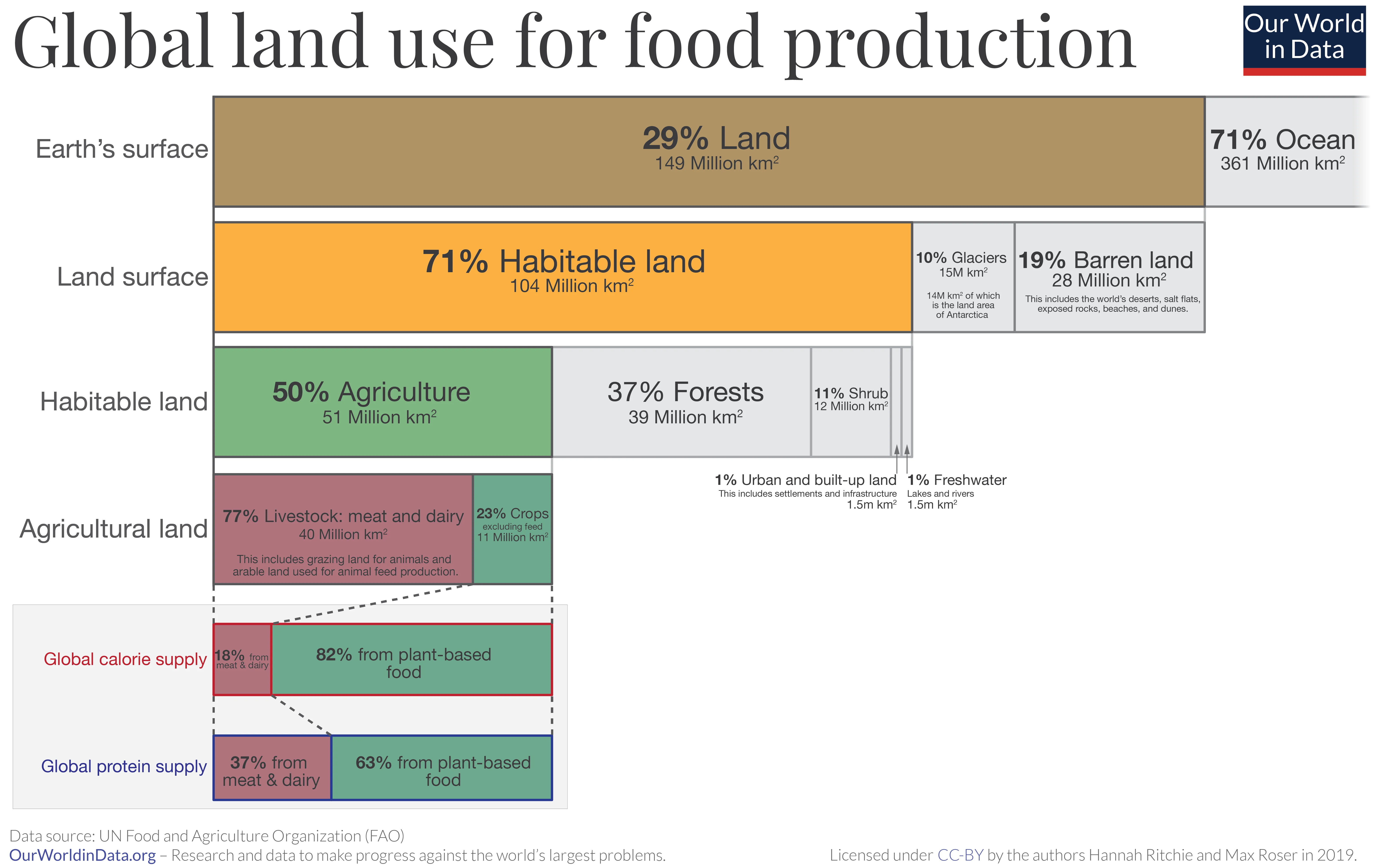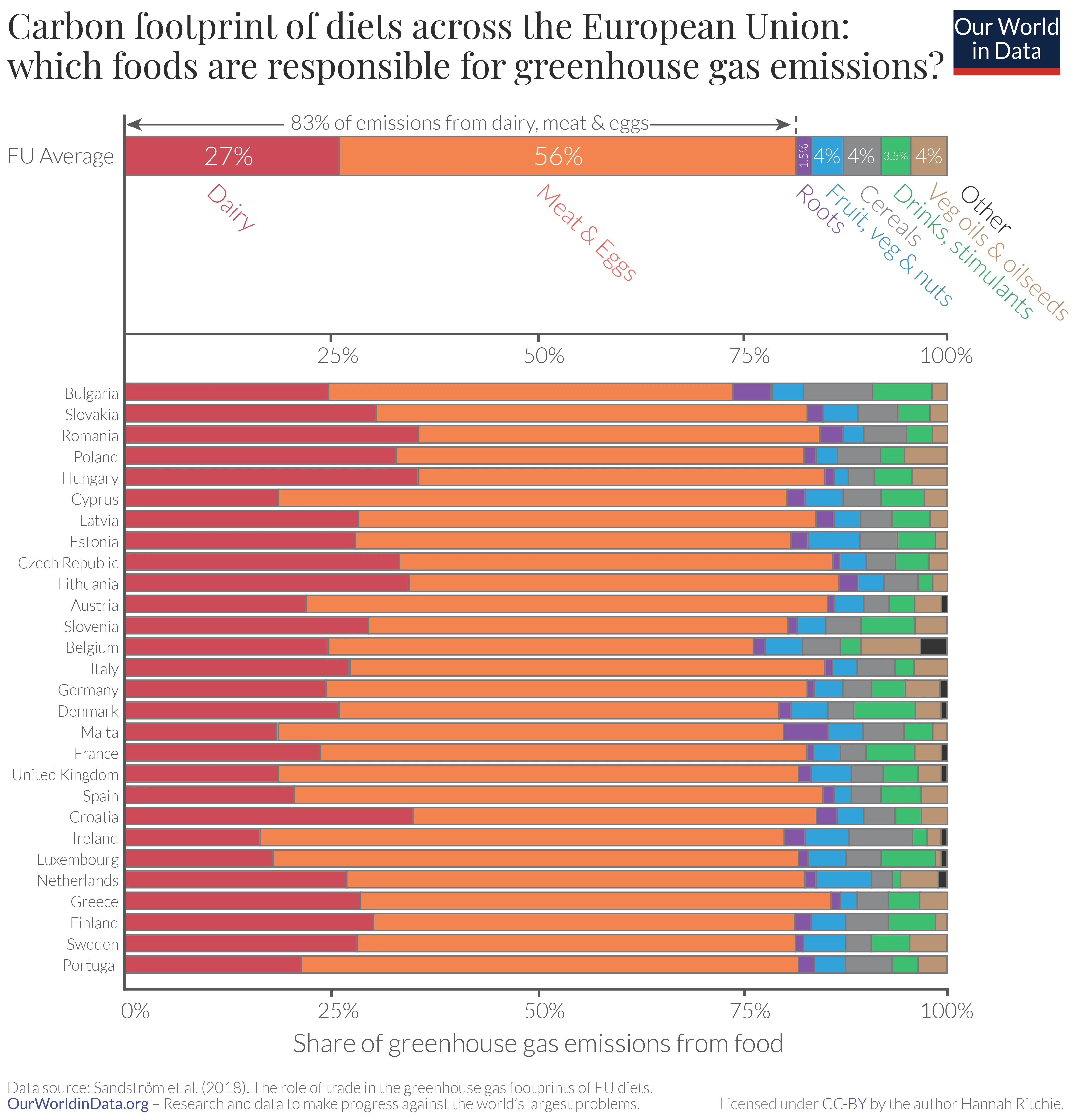A danger to biodiversity ☣️
Some 94% of the world's terrestrial mammal biomass-excluding humans-is made up of farmed animals. animals, while wild mammals account for only 6% of the world's terrestrial mammal biomass. Livestock, agriculture and aquaculture are considered a threat to 24001 of the 2,833,000 species of the 2,8338 species considered endangered by the IUCN, mainly as contributors to the destruction of natural habitats.
Livestock farming, including farms and plantations used to feed farm animals, accounts for 77% of the animals, accounts for 77% of the world's land area used for food production. worldwide. However, it provides only 18% of the calories and 37% of the protein calories that sustain the world's population. protein that sustain the world's population. In contrast, the cultivation of plants for human consumption accounts for only 23% of the calories and 37% of the protein calories In contrast, the cultivation of plants for human consumption accounts for only 23% of the agricultural area, yet provides 82% of the world's yet it provides 82% of calories and 63% of protein.

Greenhouse gas emissions 🏭
"Eat local" is a recommendation we often feel. Although it may seem logical at first glance logical at first glance, it is very ineffective advice when it comes to reducing our environmental impact. environmental impact. Food transportation accounts for only 6% of total greenhouse gas emissions from the food sector. greenhouse gas emissions from the food sector. The type of food we eat, then, is far more important than where we eat it, is much more important than where it comes from. A 2008 study in the United States concluded that substituting meat for vegetable alternatives once a week had more impact than buying all the food more impact than buyingall0 km food every day of the week.

It is estimated that the production, transport and sale of one kilo of chicken releases the equivalent of about 6 kg of CO2. about 6 kg of CO2. In comparison, plant foods such as wheat, corn, tubers, nuts, peas, tomatoes, apples, bananas, citrus fruits... release between 0.3 and 1.4, i.e. between four and twenty times less CO2. 1.4, i.e. between four and twenty times less.
Meat, eggs and dairy products account for 83% of total greenhouse gas emissions from European food. emissions from European food. In comparison, fruit, vegetables vegetables, pulses and nuts together account for 4%, cereals for 4% and tubers for 1.5%. tubers 1.5%. The remaining 7.5% comes from oils and beverages.

According to the United Nations, livestock and fish farming account for about 14.5% of the world's total greenhouse gas emissions, compared to 13% in the United States. of the world's total greenhouse gas emissions, compared to 13% from transport. emissions from transport. In other words, the consumption of meat, fish, eggs and dairy products contributes more to global warming than all cars, planes, ships, trucks and trains combined.
Fishing, an ecological disaster 🎣
The United Nations says that three-quarters of the world's fisheries are overexploited or severely depleted because of overfishing. fishing areas in the world are overfished or severely depleted due to overfishing. Today, fishing is mainly carried out through massive, non-selective nets, which, along with the fish caught, also cause that cause that, along with the fish caught, also animals and non-target species are caught. non-target species. It is estimated that more than 300,000 dolphins, whales and beluga whales are killed each year. dolphins, whales and beluga whales are killed each year as collateral damage of fishing.
Most farm-raised fish are fed fishmeal obtained from huge quantities of small fish caught in the seas and oceans. obtained from huge quantities of small fish caught in the seas and oceans, which significantly accelerates their extinction process.
A recent study conducted in the Pacific Ocean over an area of 1.6 million km2 estimates that 46% of the total weight of marine debris collected is from nets. that 46% of the total weight of marine debris collected corresponds to fishing nets, while most of the remaining 54% is also composed of other materials. nets, while the majority of the remaining 54% is also composed of other fishing materials. fishing gear. Plastic bottles, caps, bags and straws account for only 8%.
Sources 🔤
1. Bar-On, Y. M., Phillips, R., & Milo, R. (2018). The biomass distribution on Earth. Proceedings of the National Academy of Sciences, 115(25), 6506-6511.
2. iucnredlist.org
3. Poore, J., & Nemecek, T. (2018).Reducing food’s environmental impacts through producers and consumers.Science, 360(6392), 987-992.
4. Weber, C. L., & Matthews, H. S. (2008). Food-miles and the relative climate impacts of food choices in the United States. Environmental Science & Technology.
5. Sandström, V., Valin, H., Krisztin, T., Havlík, P., Herrero, M., & Kastner, T. (2018). The role of trade in the greenhouse gas footprints of EU diets. Global Food Security, 19, 48-55.
6. fao.org
7. press.un.org
8. Catching fish, not flukes and flippers
9. Sustainability of Fish Feed in Aquaculture
10. Lebreton, L., Slat, B., Ferrari, F. et al. Evidence that the Great Pacific Garbage Patch is rapidly accumulating plastic. Sci Rep 8, 4666 (2018).
To find out more 🔍
- Information on the environmental impact of different types of food
- Cowspiracy documentary on the environmental impact of livestock farming on Netflix or YouTube .
- Seaspiracy documentary on the environmental impact of fishing onNetflix